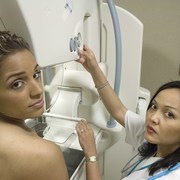According to the Mayo Clinic, breast cysts are fluid-filled sacs in the breasts. They usually occur in women between 30 and 40 years old and dissipate after menopause.
What do they feel like?
In texture, this kind of cyst usually feels like a soft grape or water-filled balloon, although it can feel firm to the touch. It inflates before the cycle and deflates after the cycle. Of course, this means that there might be tenderness. As we all know, breasts are tender at this time anyway. Now add to the fact that you have one or several (possibly one to two inches in size) lumps pulling on surrounding breast tissue!
Cause, Diagnosis and Treatment
Quite frankly, doctors don’t know what actually causes breast cysts, although some evidence points to high estrogen levels in the body. Please be advised, however, it is normal for breasts to feel lumpy. But when you feel something out of the ordinary, that’s when it’s good to make an appointment with your doctor.
After the doctor does a physical examination checking for any other breast problems he or she will judge whether further tests are needed. If so, the doctor will likely order a breast ultrasound or a fine-needle aspiration or both. An ultrasound determines if the cyst contains fluid or is solid. No, not all solid-looking masses are cancerous. It could be what is termed as a fibroadenoma.
The second procedure, the fine-needle aspiration, is when your doctor inserts a skinny needle into the breast lump and tries to pull out any fluid it contains. A cyst is immediately diagnosed if the lump deflates. However, if there’s blood withdrawn or if the lump does not deflate, additional tests are needed.
In the case of a cyst diagnosis, doctors will take the watch and see approach. You will be advised to wear a supportive bra to alleviate the pain. Some doctors (although medical evidence does not support this) advise patients to stop caffeine and salt intake. The only exception would be if the cysts are so large and recurrent as to cause extreme discomfort on a regular basis or the fluid extracted was tinged with blood. Then, surgery could be performed to ease the pressure in the case of large cysts and done as a preventive measure in the case of blood-tinged fluid.
Resources: The Mayo Clinic
Dita Faulkner is a freelance writer and advocate for all women’s medical issues.






Add a CommentComments
There are no comments yet. Be the first one and get the conversation started!